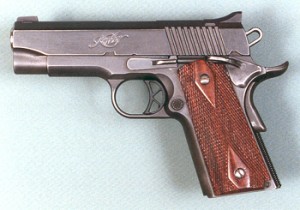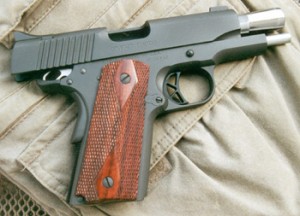By Syd

After 3 ½ years of heavy use, my beloved Kimber was looking pretty ragged. The original black phosphate finish was all but gone on the slide and I had been retouching it with cold blue. That works ok for small spots, but it doesn’t do as well on larger areas. Then after a marathon weekend of matches, I was cleaning it and noticed that the plunger tube was getting loose. Ok, time to surrender to the inevitable and take it to someone who knows what he is doing. I am fortunate that a local guy, Danny Jackson, really knows how to do the traditional gun finishes, particularly the mil-spec parkerization.
Even though I knew Danny and knew the quality of his work beforehand, it was still a bad moment when I had to turn it over to him for the face-lift, kind of like putting your baby boy on the school bus for the first time. One of my concerns was that the acid bath would take away metal and cause the gun to get loose. Danny said that the process would take a bit of metal away, but it also put it back on and bonded it to the surface. I accepted that at face value but the more I thought about the business of the bath putting the metal back on, the more I wondered about it. I realized that, while I knew what parkerization looked like, I really didn’t know how it worked. I queried a couple of the guys on 1911 TechTalk and here are the explanations that came back:

A: “Phosphoric acid is used. It replaces the iron eaten away with a phosphated coating which is fairly tough and which, being already oxidized and molecularly bonded to the underlying steel, will not crack, flake or chip.” (Frank Warren)
“The iron atoms bond with the phosphorous and some others (manganese) to make the coating. The acid bath is fairly mild & doesn’t strip off any significant dimension of metal. As it does roughen the surface, it shouldn’t be allowed to get into the bore or chamber.” (Norm Glitz)
“As I understand it, the process of “converting” creates larger surface molecules by the combining of phosphorous [etc.] atoms to the top “layer” of iron atoms, and as a result, the surface dimensions change/grow by up to a 1/2 thousandths or so. A common saying was that the conversion chemicals go into the base material as much as it adds on the outside, so, as you’re converting the molecules of the surface, a sort of “swelling” of the outer layer of molecules takes place in the process. Purely a lay description, but understandable.” (Keith Whaley)
Anyway, the gun looks great, perhaps better than it did new. I be a happy camper.
Instructions for a home parkerization job can be found at: Culver’s Shooting Page
Note: The Culver recipe was not used on my Kimber

Comments, suggestions, contributions? Let me know